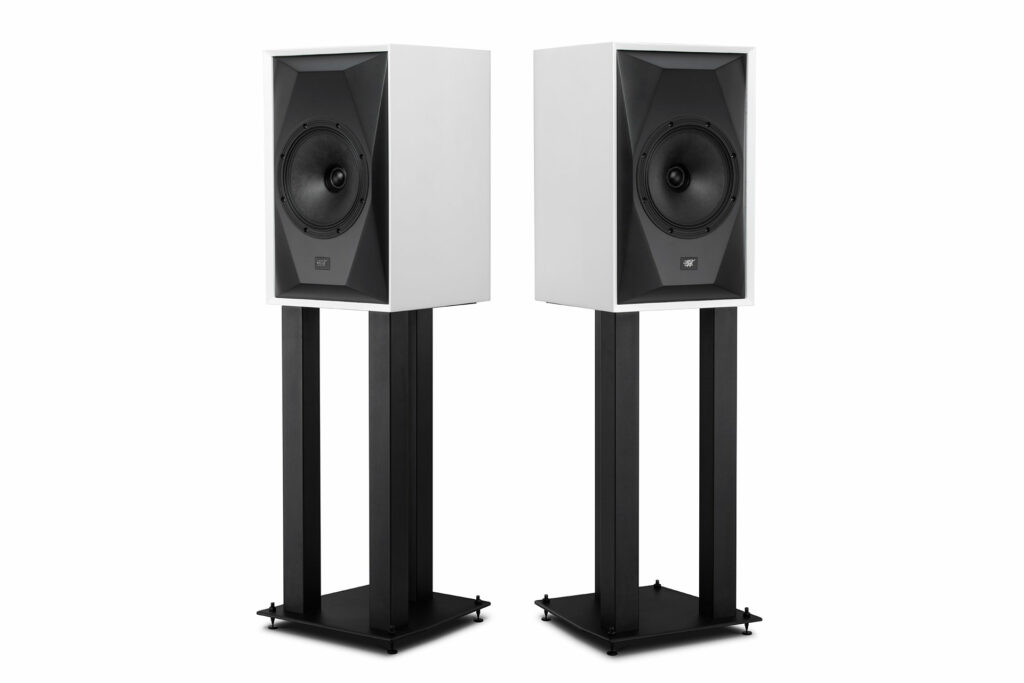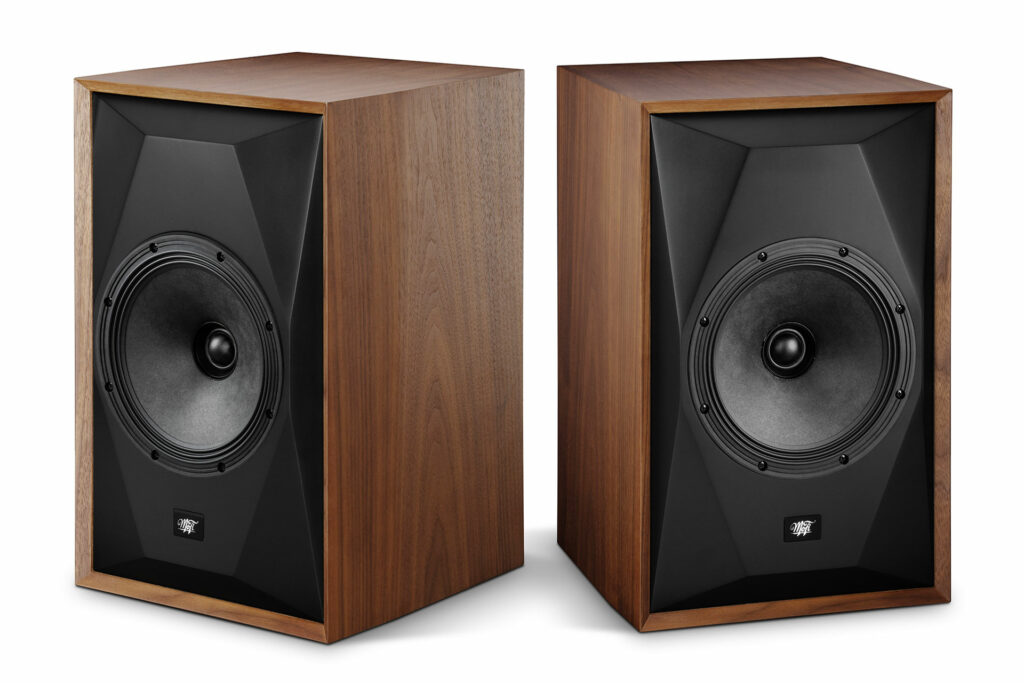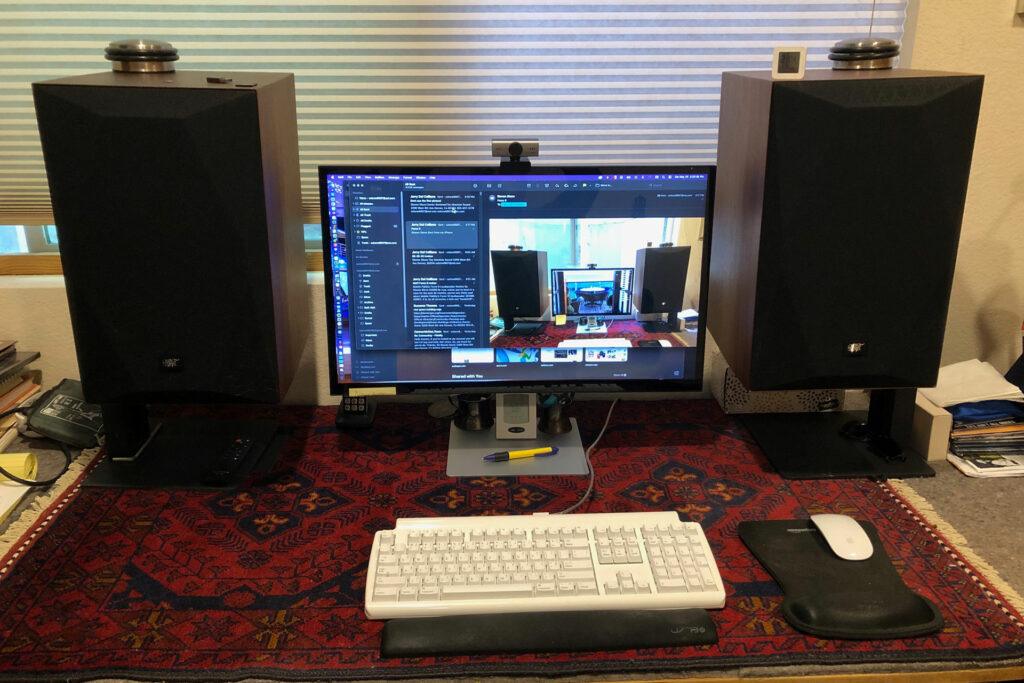By now, unless you’ve been in a cave for the past six months, you’ve very likely read about Mobile Fidelity’s SourcePoint 10 loudspeaker ($3,999 buy at Crutchfield). It is, by all accounts, a kick-ass plus-sized-bookshelf loudspeaker. But its size has implications. While suitable for medium-sized to larger rooms, shoehorning a Mobile Fidelity SourcePoint 10 into a small room or, God forbid, a nearfield or desktop system would be a less-than-optimal placement option. Darn. I really wanted to try out a pair. I even contacted MoFi about reviewing the SoucePoint 10 loudspeakers. But MoFi offered a better suggestion: “Why not review the MoFi SourcePoint 8 loudspeaker ($200 extra for stands), the new smaller-sized loudspeaker based on the same design principals?” I acquiesced, obviously, so here we are.

What Makes the MoFi SourcePoint 8 Audiophile Loudspeaker Special?
- The SourcePoint 8 is a coaxial design. This means that the 1.25-inch tweeter is situated inside the eight-inch midrange/woofer cone. The woofer cone also serves a waveguide for the tweeter. This was a hallmark of the British manufacturer KEF, one of first employers of Andrew Jones, who was responsible for the MoFi SourcePoint 8 design. After leaving KEF, Jones designed for Pioneer and then ELAC. I own a pair of ELAC Adante AF-61 floorstanding loudspeakers he designed that also use a coaxial tweeter nestled inside the midrange driver. I could fill paragraphs with the technical reasons why this arrangement has sonic benefits that result in very desirable dispersion characteristics, so even off axis the speaker’s frequency response remains remarkably even.
- Its coaxial driver has a special magnet structure. The loudspeaker employs something that MoFi calls “Twin magnet structure” using neodymium magnets. This dual structure delivers greater linearity throughout the driver’s excursion range.
- It isn’t a square box. To the untrained eye, it appears to be a rectangular box, but if you look carefully, or feel along the sides, you’ll discover it has a bend that begins about five inches in, so the sides are not parallel.
- The SourcePoint 8 is no lightweight. The cabinet uses 3/4-inch thick, real wood veneers as well as extensive internal bracing and a sculpted 1.5-inch-thick front baffle, all of which adds up to the MoFi SourcePoint 8 loudspeaker’s 27.9-pound fighting weight.
- Dedicated speaker stands are available for the loudspeaker. 22-inch-high stands place the MoFi SourcePoint 8 at the perfect height. Their three-pole design allows for filling the columns. They come with spikes, spike plates, and neoprene and felt pads.

Why Should You Care About the MoFi SourcePoint 8 Loudspeaker?
I’m pretty sure you’ve heard the story of Goldilocks, the fable about the search for a perfectly sized thing. For folks with small rooms or those who listen mid-field, the MoFi SourcePoint 8 could be the perfect porridge. I can see these speakers being used in home studios because they would ideally fit that environment as well. Among the MoFi SourcePoint 8’s strong points are its warm, easy-to-listen-to tonal balance, excellent dynamic contrast and range, fine depth recreation, and scary-good three-dimensional imaging capabilities. A visiting friend called the MoFi SourcePoint 8 loudspeakers voluptuous. I guess for him, they were.
Some Things You Might Not Like About the SourcePoint 8
- Unless you’re slightly nuts, like me, you will most likely find the MoFi SourcePoint 8 a bit too large for desktop use. Nearfield positioning on stands with the MoFi SourcePoint 8 might work a little better if you can give them some distance away from a wall.
- The MoFi SourcePoint 8 lacks upper frequency air. Hiss from tape sources or electronics are truncated, which can, depending on your source, be an OK thing, or a maybe even good thing… or not. If your listening revolves around getting that last scintilla of upper frequency content, the SourcePoint 8 might not be your cup of tea.
- You may find the walnut finish drab. Trying to describe the SourcePoint 8’s finish is challenging. It’s rougher than satin, and almost appears to be a natural mat finished veneer. It might be your bag; it might not.
- The MoFi logo on the speaker grill and speaker cabinet is not removable. It’s shiny and will reflect light. It’s the only physical feature on the SourcePoint 8 that I would prefer wasn’t there, or at least was removable. Speaking of removable, trying to take the grills off could break a nail of two; they do not surrender easily since their edges mate with the cabinets so tightly.
Listening to the MoFi SourcePoint 8 Audiophile Loudspeakers…
The most impressive aspect of the SourcePoint 8’s sound is how easy it is on the ears. I often listen to music for hours at a time. Even after multiple minutes at high SPLs (I usually max out at 85 to 90 dB at listening position) no listener fatigue sets in. While not overly soft, the MoFi SourcePoint 8 loudspeakers do seem to attenuate very high frequency hash or distortion in an extremely euphonic way. Don’t think they make all sources sound similar. Nasty stuff is still nasty if it was recorded that way, but everything is listenable through the MoFi SourcePoint 8 loudspeakers. They have a very pleasant overall voicing.
This is a good place to mention the MoFi SourcePoint 8’s low end. While the bass frequencies don’t extend any lower than you would expect from a box this size with two rear-facing ports, it does kick hard. John Bonham’s drums and that amazing bass line from John Paul Jones on Led Zeppelin’s “Dazed and Confused” will punch you mid-chest if you get the volume just right. For me 80 dB average, A-weighted at listening position is loud enough to do the trick.
The SourcePoint 8s produce a remarkably well-defined three-dimensional image from music that has that information. Given their size and shape, their ability to sonically disappear ranks as one hell of a magic trick. Their front baffle geometry combined with the coaxial driver produces a soundstage that rivals much smaller single-driver loudspeakers. The SourcePoint 8’s imaging prowess is certainly on display on the Billie Eilish’s track “Xanny”. Eilish’s lead vocals originate in the center before proceeding to yo-yo between the right and left channels. The background vocals seem to originate from a place outside the physical boundaries of the loudspeakers while the burbling background walls seems to come from a place far in back of the room.
The intentional mid-bass distortion on “Xanny” demonstrates how well the SourcePoint 8 loudspeakers can handle distortion accurately without adding any of its own signs of distress.
Does the MoFi SourcePoint 8 Loudspeaker Have Any Resale Value?
It surely will have resale value as a brand new speaker to the market as of right now. Don’t expect to get the full price that you paid for them new, but I would expect a used pair of SourcePoint 8s will go for around $2,000. But don’t hold your breath anticipating used or demo samples flooding the used market. The MoFi SourcePoint 8 will be in short supply and great demand for a while, and it will take some time before some early adopter moves on to another loudspeaker.

Who Is the Competition for the MoFi SourcePoint 8 Loudspeaker?
If your listening room is at least midsized or larger, you may find the MoFi SourcePoint 10 loudspeaker to be a better fit for your room. It goes a bit lower in the bass and has a few dB greater sensitivity, so it should be able to play a bit louder with no signs of distress, but you will get a very similar sonic result. For my uses, I find the SourcePoint 8 has more utility since it can fit into more setups and is easier to lug around, but for some folks the bigger MoFi SourcePoint 10 will be a better option.
One of my previous primary reference nearfield loudspeakers is the ATC SCM-7 III, which I reviewed here recently. The SCM-7 III is a bit more matter-of-fact and less euphonic than the SourcePoint 8. Its size makes it a better fit for most nearfield and desktop systems, and it’s less than half the cost of the SourcePoint 8.
Many of the MoFi SourcePoint 8’s best sonic characteristics remind me of the Alta Audio Alyssa loudspeaker ($5,000 per pair) I reviewed for The Absolute Sound in 2021. Both loudspeakers are euphonic yet detailed. Both are also at the upper size limits I would try to use for a nearfield audio setup. The Alyssa uses a specially designed Morel midrange/woofer combined with a Fountek folded ribbon tweeter and has a much slicker looking exterior, which you would expect given its price.

Final Thoughts on the MoFi SourcePoint 8 Loudspeakers
I’ve been living with the SourcePoint 8s as my primary nearfield reference for the past month. I am loath to remove them. Their midrange has a seductive quality, not because it’s overly warm or euphonic, but due to its detail, harmonic complexity, and imaging precision. For my nearfield listening requirements, the MoFi SourcePoint 8 works beautifully.
Whether you will find the SourcePoint 8 loudspeaker equally delectable depends on the environment you place it in. Combined with a good subwoofer, like the recently reviewed ELAC Varro Reference RS500 , in a nearfield, small room, or even a mid-sized room with subwoofers, I suspect that you very well find yourself as enamored by the SourcePoint 8 loudspeakers as I am.




Great music choices Steve!
The headline says “Point Source 10” loudspeakers, but the review is for the Point Source 8’s.
Good catch Tom.
100% mistake on my part as I did the layout.
I fixed it after I got home from golf today. (I didn’t use to suck this bad at golf btw)
I’m the proud owner of one Andrew Jones’ excellent Elac speakers but I believe he’s gone off the rails at Mofi. A dual concentric midrange driver paired with a woofer would have been a less expensive solution. Trouble is he already did that at Elac and Kef is doing it successfully too. So it’s a very expensive change for changes’ sake and no one is calling him on it?
Off the rails? In what universe? I too have ELACcs that I enjoy, but that does not make everything else he designs some sort of transgression…perhaps MOFI will let you design their next loudspeaker… 🙂
Still a very expensive change for changes sake and no one is calling him on it? I just expected better from him but maybe he’s getting tired of the speaker design fashion industry.
“Changes for Changes sake” ?!?!?! Have you even heard the Sourcepoint 8? You have qualified yourself as a troll. Please go back under your bridge…
So legitimate criticism is trolling? I’ll remember that for the future and only comment when I’ve got something fabulous to say.
“Legitimate criticism”? You really have no clue. You said “Expensive change”…Andrew used to design FAR more expensive designs for both KEF and ATC…And compared to his ELAC designs, this is a far more sophisticated design and FAR more costly to manufacture. Horses for courses. News Flash – the world does not revolve around your particular tastes and desires…Now “legitimate” criticism would be “I wish MOFI had not cheaped out on that satin finish. For that money I want gloss.” THAT would be legitimate criticism. See the difference?
You obviously do not understand my criticism. This has all been done before in the UK market (Tannoy, Fine & Kef) but is unusual in the present US market. I, of course, understand that these Mofi designs are more costly to manufacture than the Elacs but, a factor of ten, seems outrageous. Maybe he had nothing to do with the pricing but he is publicly promoting the Mofis, so is open to criticism, a little different to his TAD days.
So, you are comparing $300 ELACs with $3000 MOFI’s? Really? The MOFI has a further refined the ELAC technology using the same computer modeling methodology pioneered while he was with ELAC. To be honest I find your criticisms to be based on little by of any concrete facts. You are entitled to feel any way you choose, but to consider that realistic criticism is quite a stretch…
You don’t see the benefit of a concentric design that uses a large paper-cone in lieu of the typically smaller aluminum drivers from KEF? You can’t even imagine what the benefits in mid-range/bass due to size alone? Or how silk dome tweeter/paper cone might render a more natural tone than KEF’s metallic approach?
Well, having some of AJ’s previous speakers here, in addition to KEFs, I can tell you from my own experience that the Sourcepoint 8s flat out steal the show. They are special. I am no speaker designer, but it seems to me AJ’s unique approach seems to have paid dividends. It combines all of the benefits of concentric with the natural timbre of a silk dome and fat paper cone.
As far as I am aware, the last time this particular combo of woofer materials, size, and design was implemented was Tannoy. That alone might be good reason for someone to do it again.
Would have liked to hear how they stack up to the KEF LS50 Meta’s. Send me both and I’ll handle it 😉
Really appreciate the article and more importantly having the speakers in a near-field position. I’m looking at a similar setup. Does the low end ever become an issue in your room? Any comparisons to speakers with passive radiators (Amphion/Buchardt)?